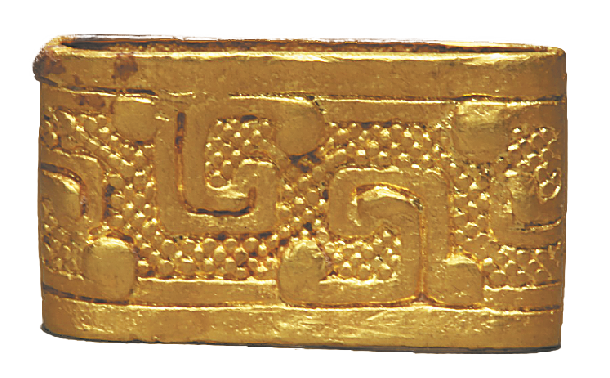 Gold artifacts with snake and tiger motifs, unearthed from Xiazhan site in Baoji, Shaanxi province. [Photo provided to China Daily]
Gold artifacts with snake and tiger motifs, unearthed from Xiazhan site in Baoji, Shaanxi province. [Photo provided to China Daily]
In Beijing, the Temple of Heaven has stood for centuries, silently standing in testament to Chinese people's awe of the divine and their sacrificial custom to the heaven in the Ming (1368-1644) and Qing (1644-1911) dynasties — a custom that actually has a much longer history.
Ancient Chinese people believed that "the great things in a country are its sacrificial and military affairs", as stated in Zuo Zhuan (The Commentary of Zuo), the first detailed historical annal in China, dating back to the 4th century BC.
Our understanding of ancient Chinese people's sacrificial rites has been enhanced thanks to the archaeological work taking place at the Xiazhan site in Baoji, Shaanxi province, since 2020. The dig has been carried out by the National Museum of China and the Shaanxi Academy of Archaeology, among others. The latest discoveries were announced at a news conference in December held by the National Cultural Heritage Administration.
More than 1,400 sacrificial relics have been found at the site, which covers an area of 230,000 square meters. Archaeologists have excavated 99 pits that date from the Spring and Autumn Period (770-476 BC) to the Western Han Dynasty (206 BC-AD 24), and exhibited clear differences between them. The site is believed to be mizhi, a sacrificial site established by Duke Xuan of Qin state (ruler of the state over 675-664 BC) in 672 BC.
According to You Fuxiang, a researcher at the National Museum of China, the pits in the site mainly have three shapes, namely long-strip, rectangular and cave forms.
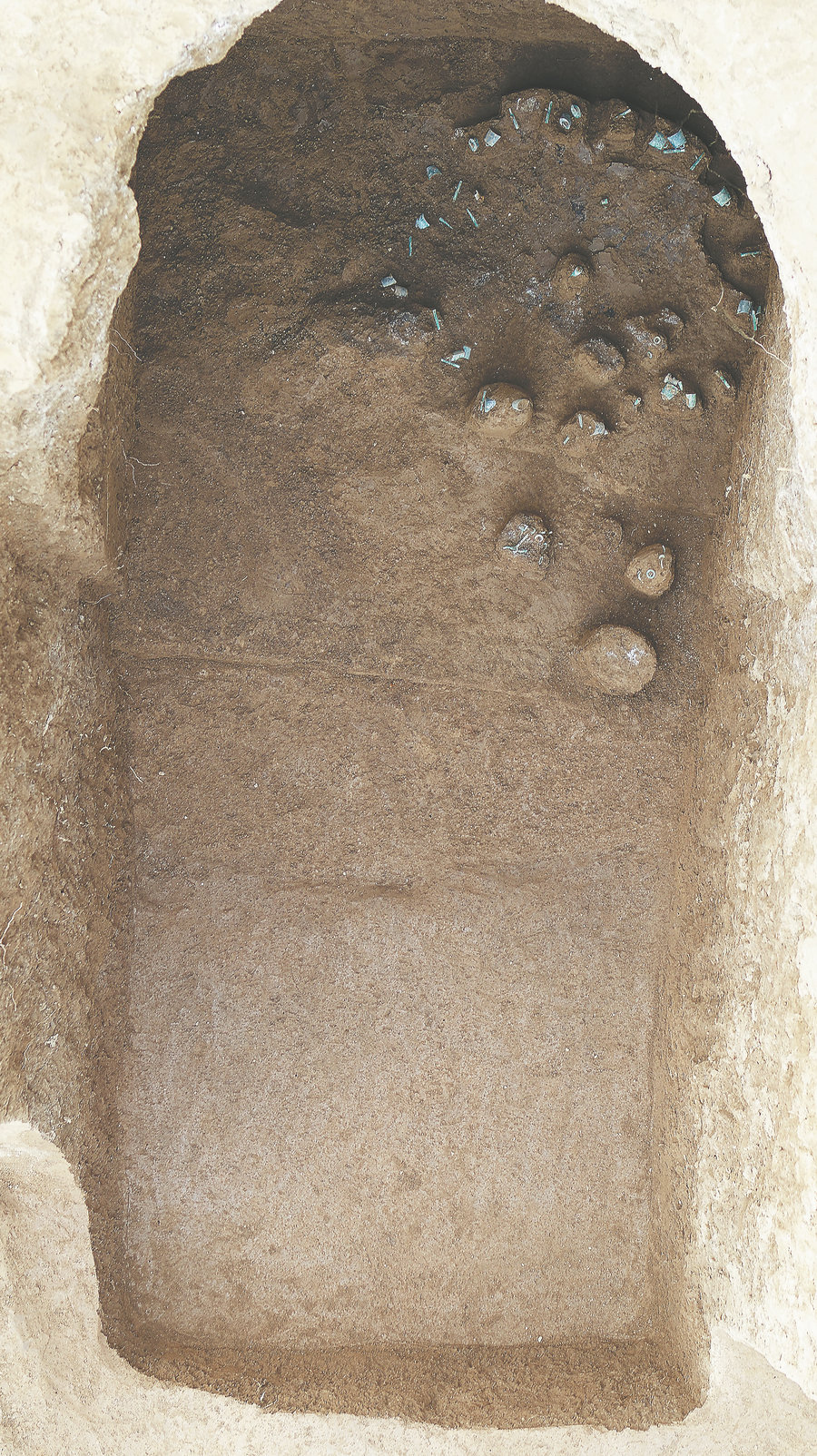 A cave-form sacrificial pit with model chariots. [Photo provided to China Daily]
A cave-form sacrificial pit with model chariots. [Photo provided to China Daily]
At the center of the site, there is an area where building materials are stacked, covering about 2,000 sq m. Various sacrificial pits are distributed around it.
The first one, a long strip, located on the eastern side of the site, dates back to the middle stage of the Spring and Autumn Period. Such pits range in length from about 10 to 100 meters, and often have the remains of cattle that were used as sacrificial offerings, the heads of which point northward.
The rectangular pits, located at the west of the site and dating from the late Spring and Autumn Period to the Western Han Dynasty, contain mainly three types of remains, animals, chariots and model chariots.
The largest of them is 8.7 meters long and 7.9 meters wide, and has a depth of more than 12 meters. It fell victim to robbers, but archaeologists suggest that it would fit four chariots, based on its size.
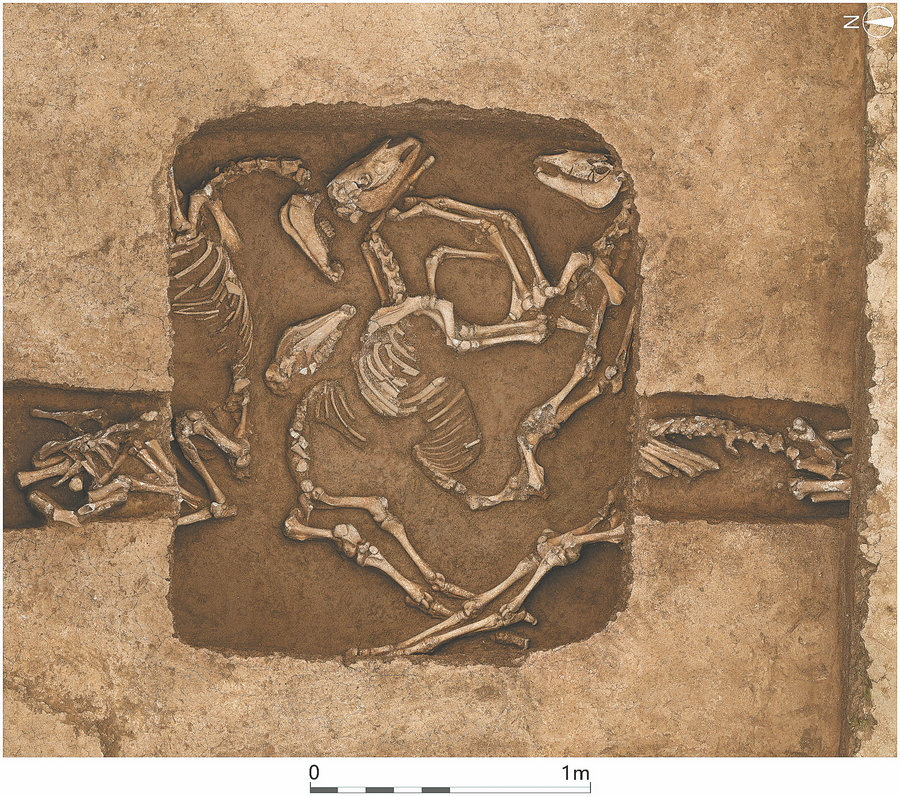 A sacrificial pit with animal remains. [Photo provided to China Daily]
A sacrificial pit with animal remains. [Photo provided to China Daily]
Some chariot-related artifacts unearthed are similar to those discovered from the Tomb No 1 of the Duke of Qin in Baoji, where Duke Jing of the Qin state (ruler of the state over 576-537 BC) was buried. This means that some pits were contemporaneous with the tomb, says You.
"From the Warring States Period (475-221 BC) to the Qin (221-206 BC) and Han (206 BC-AD 220) dynasties, the chariot pits gradually shrank. The life-size chariots were later replaced by models. Moreover, jade artifacts like figures, arch-shaped items known as huang and various cylindrical cong, as well as arrowheads, began to be put in the chariot and it became a custom," says You.
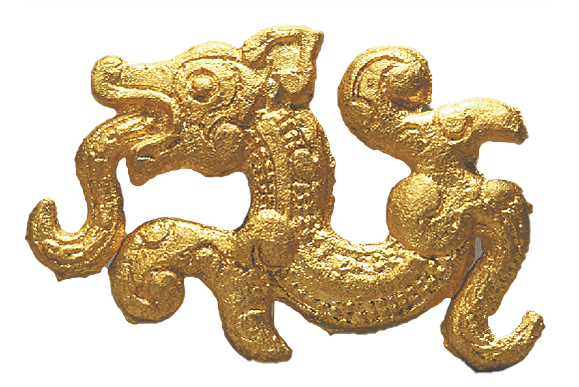 Gold artifacts with snake and tiger motifs, unearthed from Xiazhan site in Baoji, Shaanxi province. [Photo provided to China Daily]
Gold artifacts with snake and tiger motifs, unearthed from Xiazhan site in Baoji, Shaanxi province. [Photo provided to China Daily]
Pits of the third type were from the Warring States Period to the Western Han Dynasty. They often contained model chariots.
A large number of gold, jade and bronze chariots from the Spring and Autumn Period, jade artifacts, bronze chariots and crossbows, arrowheads, coins and architectural items from the Qin and Han dynasties have also been found at the site.
"Many of the gold and jade artifacts are distinctively Qin-style, like gold tigers and birds, or have Qin-featured patterns, like that of a snake," says You.
The Chinese character mi can be seen when two pottery pieces unearthed from the site are pieced together. Based on historical records, and the character, archaeologists infer that the area is indeed mizhi, one of the five sacrificial sites near Yongcheng, one of the capitals of the Qin state in what is now Baoji.
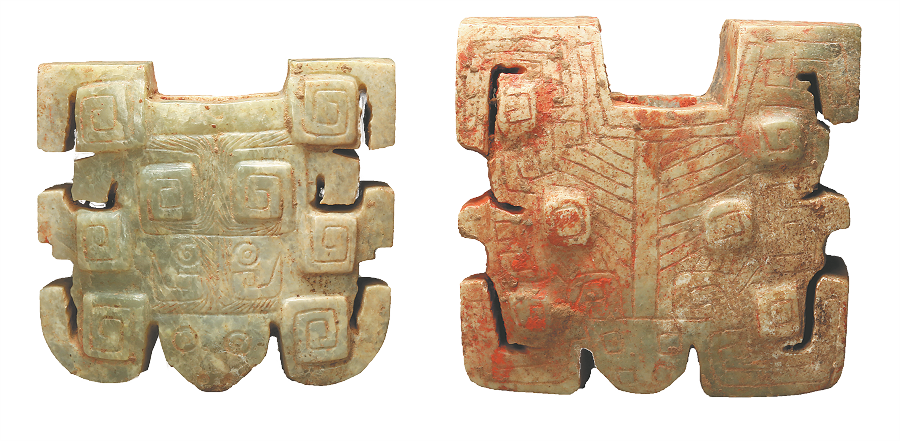 Two jade artifacts with beasts' faces. [Photo provided to China Daily]
Two jade artifacts with beasts' faces. [Photo provided to China Daily]
The five places were jointly called yongwuzhi (five sacrificial places in the Yongcheng area), and were used to worship five mythical rulers who symbolize heaven. They were built one by one from the Spring and Autumn Period, and officially became a collective entity at the beginning of the Western Han Dynasty and functioned until its end.
Mizhi is the only one of the five sites of which there was a clear record of its specific location: to the south of the Weihe River. The site's location fits with this record, according to You.
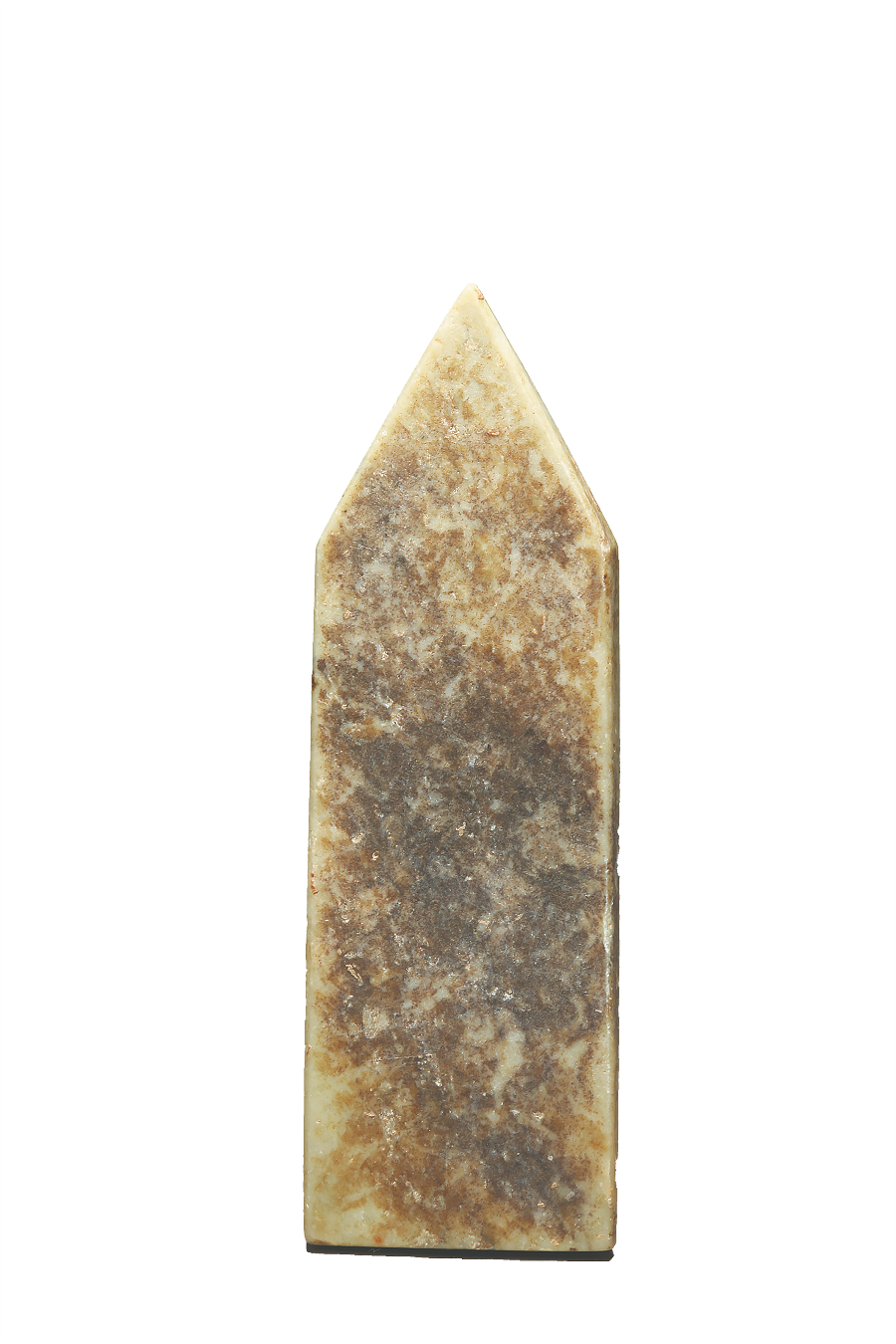 A jade artifact often used in rituals in ancient China. [Photo provided to China Daily]
A jade artifact often used in rituals in ancient China. [Photo provided to China Daily]
Since 2015, an archaeological team started to carry out studies on the five sacrificial sites. Archaeologists have found four sacrificial sites in Baoji and excavated three of them, namely Xuechi, Wushan and Xiazhan, and suggest that they were all constituent parts of yongwuzhi.
The Xiazhan site is 21.8 kilometers from Yongcheng city ruins, 35 km from the Xuechi site, and 59 km from the Wushan dig.
Some chariot pits at Xiazhan are similar to those from the Xuechi and Wushan sites, says You.
"With the establishment of the Qin Dynasty, yongwuzhi upgraded from the sacrificial sites of a vassal state to places to worship heaven as a country, showing the development of China's traditional ritual culture," says You.
He adds that the custom was inherited by the Western Han Dynasty later.
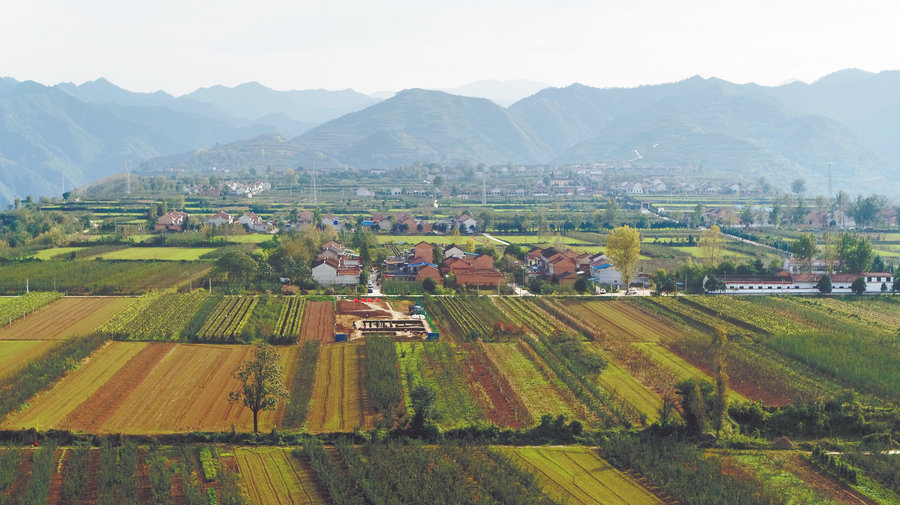 An aerial view of the Xiazhan site. [Photo provided to China Daily]
An aerial view of the Xiazhan site. [Photo provided to China Daily]
When scholars conduct archaeological studies on settlement sites or city ruins of the Qin and Han dynasties, capitals, tombs and sacrificial sites are the three major elements they pay attention to.
That means the importance of sacrificial sites is not second to capitals or tombs, says Jiao Nanfeng, a researcher at the Shaanxi Academy of Archaeology.
Most of the sacrificial sites of the Qin and Western Han dynasties recorded in historical literature have been found, forming a complete sacrificial system of that time, Jiao says.
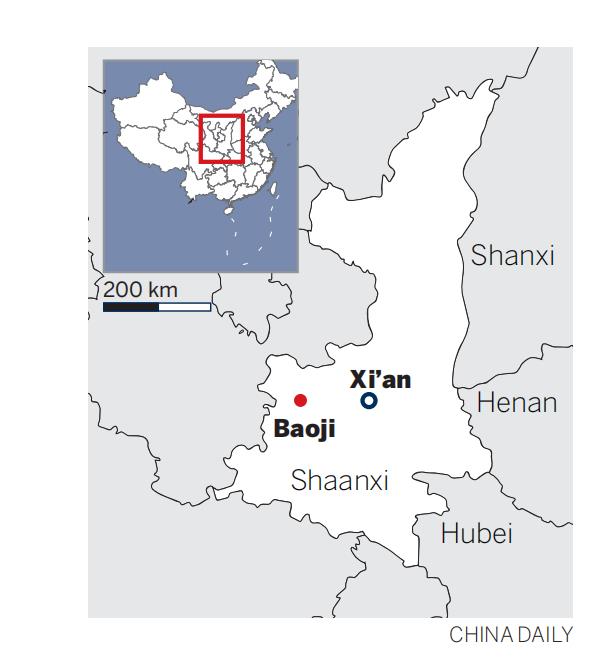
"So far, we have learned that the Qin people's sacrificial system mainly consisted of three types, one to worship ancestors, like the Majiazhuang ancestral temple ruins in the central area of Yongcheng city ruins, one to worship heaven like yongwuzhi and the last to worship mountains and rivers," says Jiao.
"Yongwuzhi, represented by the Xiazhan site, was an important stage for rituals that worshipped heaven in ancient China," he adds.
During the reign of Emperor Wu of the Han Dynasty, from 141 to 87 BC, the status of Yongcheng and yongwuzhi gradually declined. And yongwuzhi was totally replaced by temples of heaven and earth in Chang'an, the capital at the time in what is now Xi'an, Shaanxi province, at the end of the Western Han Dynasty.
According to Jiao, although yongwuzhi ceased to function then, the content, form and central connotations of the sites remained and, in many facets, were developed during later dynasties, shown by the function of the Temple of Heaven in Beijing, where Ming and Qing emperors regularly went to worship heaven and pray for rain and a good harvest.





